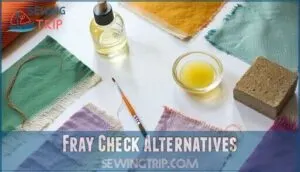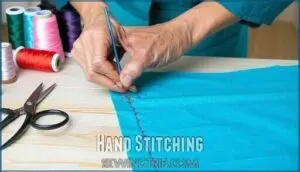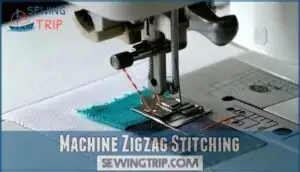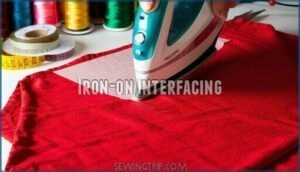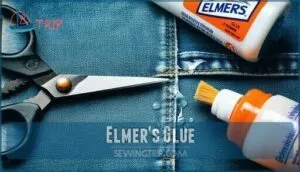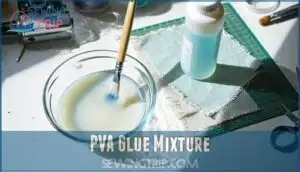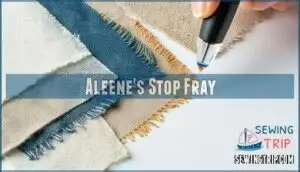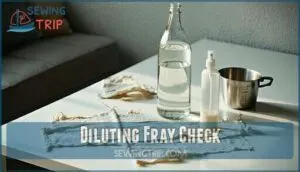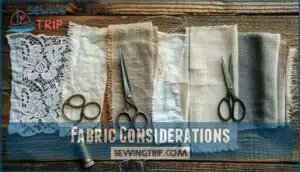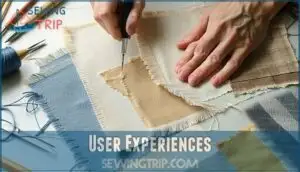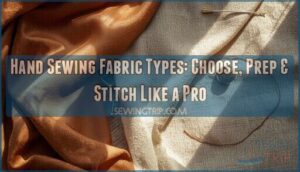This site is supported by our readers. We may earn a commission, at no cost to you, if you purchase through links.
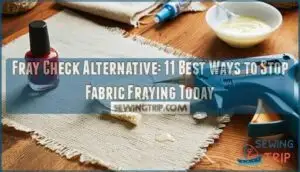
Clear nail polish works well on small areas. For larger projects, fabric glue or liquid stitch can do the trick—they dry clear and stay flexible.
Got a hot glue gun? That’s another option for thicker fabrics. DIYers can mix water with PVA glue for a budget-friendly solution.
If you’re in a pinch, even a little super glue can seal edges fast (just watch for stiffness). Each method has its quirks, so match the alternative to your fabric for the best results, and keep experimenting with different techniques to find what works best for you, as each fabric type may require a unique approach to prevent unraveling, and to achieve a flexible finish.
Table Of Contents
Key Takeaways
- You’ll find many household items can replace Fray Check—clear nail polish works for small areas, while fabric glue or liquid stitch handle larger projects while maintaining flexibility.
- You don’t need to spend a lot—budget-friendly alternatives include a simple PVA glue and water mixture (50:50 ratio) or Elmer’s glue diluted with water for effective edge sealing.
- You should match your fraying prevention method to your fabric type—delicate fabrics like velvet need gentle solutions, while synthetic fabrics can be sealed with a careful pass of a lighter.
- You can use simple tools for precise application—toothpicks, small paintbrushes, or eyedroppers help you control the amount of product and prevent stiffness from over-application.
Fray Check Alternatives
If you’re out of Fray Check, you’ve got plenty of other options to stop fabric from fraying.
From clear nail polish to homemade solutions, each method offers a simple way to keep your fabric edges neat and secure, using simple ways.
Clear Nail Polish
Using clear nail polish as a Fray Check alternative is simple and effective for raw edge finishing.
Clear nail polish offers a quick, budget-friendly fix, sealing raw fabric edges with ease for lasting, invisible protection.
Carefully tap it along cut edges for an invisible, durable seal.
Its antifray solution works on most fabrics, though it may add slight stiffness.
Compared to Fray Check, it’s budget-friendly, making it a smart choice for cost-conscious projects needing quick, reliable edge treatment.
Fabric Glue
Fabric glue is a versatile Fray Check alternative for cut edge treatment and fabric stabilization techniques.
It’s ideal for preventing fraying, as it bonds quickly and offers durable results. Choose fabric-specific glue brands for better washability and reduced glue stiffness.
Apply with a brush for precision and avoid overuse to maintain flexibility. It’s a simple, effective antifray solution.
When fabric glue runs out, consider fusible tape alternatives for a quick fix, using a versatile and effective method.
Liquid Stitch
Liquid Stitch works as a popular Fray Check alternative, offering convenience and strength.
This fabric glue bonds materials securely, making it useful for fabric fray prevention and minor repairs. You can find a variety of options online.
- Versatile Uses: Great for hems, seams, and edges.
- Ease of Application: Squeezes directly from the bottle.
- Durability: Once dry, it’s wash-friendly and long-lasting.
Super Glue
Super Glue, with its quick-drying strength, works as a fray check alternative for fabric fray prevention.
Apply a thin line on edges, but test first—its long-term effects vary by fabric.
It’s not ideal for delicate materials like silk. Residue removal can be tricky, so precision is key.
For robust antifray solutions, Super Glue can prevent fabric unraveling effectively.
Homemade Fray Check
Try making your own fabric sealant! A common homemade fray check uses a PVA glue ratio—half glue, half water—for fabric fray prevention.
Apply with a small brush for precise coverage. Alcohol dilution can improve flow and reduce glue stiffening.
It’s a budget-friendly option with decent homemade longevity, offering antifray solutions for those seeking simple, effective alternatives to store-bought fabric sealants, providing a good homemade longevity.
Fray Prevention Methods
You’ve got plenty of options to keep fabric edges neat and secure without using Fray Check.
From stitching techniques to simple tools like lighters, these methods are easy to follow and highly effective.
They are easy to follow and can be used in a variety of situations.
Hand Stitching
Hand sewing is a versatile way to prevent fraying.
Techniques like the overcasting stitch, whip stitch, and zigzag stitch are great for securing edges.
Maintain proper stitch tension to avoid puckering.
For fabrics like Aida and evenweave, handsewing with a needle and thread offers control and precision.
Experiment with thread securing methods to achieve clean, durable edges.
Machine Zigzag Stitching
A zigzag stitch is a great way to keep fabric edges from fraying.
Adjust the stitch width and length on your sewing machine for a snug fit. Proper tension settings and using the right needle type are key sewing tips.
Make certain the fabric feed moves smoothly, and practice sewing techniques on scraps to perfect clean edges.
Regular maintenance helps in repairing sewing machine, which is a crucial step for ensuring your machine continues to perform the clean edges you need.
Iron-on Interfacing
Iron-on interfacing is a smart way to stop edges from unraveling. It fuses seamlessly onto fabrics, creating durable reinforcement.
To use iron-on interfacing, follow these steps:
- Choose the right interfacing type based on fabric compatibility.
- Place the fusible side down, pressing with an iron for strong bond strength.
This method is perfect for knit stabilization and textile fray prevention, ensuring sleek seam edge finishing. Many options are available for purchasing this product, making it a durable reinforcement solution.
Using Lighter
A lighter is a quick, nonsewing solution for fabric fray.
Hold it near fabric edges and carefully run the flame along them.
Synthetic fabric dissolves fast, so control the flame closely.
Always prioritize safety precautions—no loose sleeves!
Test on scrap pieces first, as some fabric types scorch easily.
This lighter technique works well but requires patience and steady hands.
Cost Effective Solutions
If you’re looking to stop fabric fraying without spending much, there are plenty of budget-friendly options to try.
From Elmer’s glue to homemade solutions, these methods save money and get the job done effectively.
Elmer’s Glue
Elmer’s glue is a handy, nonsewing solution for fabric fray.
Dilute it with water for better spreadability and test for fabric compatibility first. Use a small brush for precise application along fabric edges.
Drying time varies, but a hairdryer helps. While it’s not permanent, it works well for short-term fixes.
Elmer’s also offers fabric glues specifically designed for textiles. Avoid saturating to prevent stiff edges.
PVA Glue Mixture
PVA craft glue is a smart, affordable option for fray prevention. A simple 50/50 PVA ratio with water works wonders.
Apply with a small brush or toothpick for precision. Test on scraps to control fabric stiffness and drying time.
Here’s how:
- Mix glue and water.
- Brush lightly onto edges.
- Let it dry.
- Avoid oversaturation.
- Enjoy lasting results!
Aleene’s Stop Fray
Aleene’s Stop Fray is a budget-friendly fray check alternative for sealing fabric edges.
It dries clear, works well on most fabrics, and is great at preventing fabric unraveling.
Its thicker consistency makes application easier, though drying time is slightly longer.
Ideal for cost-conscious crafters, it guarantees fabric compatibility and effective fray prevention, offering long-term effects without breaking the bank.
Consider that loose weave fabrics are especially prone to fraying, which makes fray prevention crucial.
Diluting Fray Check
Looking for Fray Check alternatives? Diluting Fray Check with a solvent is one way to stretch your dollar. Use a 50:50 ratio for effective results.
Here’s how you can experiment:
- Mix solvent carefully to avoid fabric hardening.
- Test on scraps first for fabric compatibility.
- Apply sparingly to reduce stiffness.
- Adjust dilution ratios as needed.
- Watch longevity impact with repeated use.
This method allows for effective results and helps in reducing stiffness, making it a viable alternative for those looking to save money without compromising on quality.
Reusing Fray Check Bottles
Cleaning used Fray Check bottles saves money and cuts waste.
After rinsing, refill them with DIY mixtures or affordable alternatives for fabric treatment. Small bottles are perfect for precise application while minimizing mess.
Consider these ideas:
| Task | Tip | Benefit |
|---|---|---|
| Bottle Cleaning | Use warm water and soap | Preps for reuse |
| Refill Solutions | Try diluted PVA glue | Cost-efficient |
| Applicator Options | Add a squeeze nozzle | Better fabric control |
Fabric Considerations
Choosing the right fray prevention method depends a lot on the type of fabric you’re working with.
From delicate mohairs to stretchy knits, understanding your fabric’s unique characteristics will help you avoid frustrating mistakes, especially when considering complete concepts and delicate fabrics.
Mohair Fabrics
Mohair fabrics, prized for their soft texture, often have a dense weave that minimizes fraying.
Still, some weaves may need sealing, especially during detailed projects.
To address mohair’s fraying tendency, consider fabric edge sealing with a fray check alternative like clear nail polish or PVA glue mixtures.
Always test beforehand, as mohair’s specific weave density impacts the effectiveness of these methods.
Velvet Fabrics
Velvet fabrics are luxurious but tricky—prone to fraying along edges due to their delicate nap.
To tackle velvet fraying issues, use fray check sparingly or try fabric edge sealing with fabric glue.
Always follow the velvet nap direction when cutting or sewing for a smooth finish.
For more durability, consider hand-stitching edges or applying interfacing for added stability.
Knit Back Fabrics
Knit back fabrics can stretch easily, making proper edge finishing a must.
Iron-on interfacing is a handy fix, offering fabric stabilization and stretch prevention.
If sewing challenges arise, try sewing alternatives like a zigzag stitch for added knit fabric protection. For a fray check alternative, consider Aleene’s Stop Fray or PVA glue. These support fabric stability brilliantly!
Different Fabric Weaves
Weave density, fiber type, and yarn construction influence fabric fraying.
Loose weaves like twill fray more than tighter ones like plain weave. Surface texture also plays a role—smooth fabrics often fray less.
For woven fabric protection or knit fabric protection, focus on these factors. Understanding drape quality helps manage fraying too, especially on natural and synthetic fabrics.
- Tips:
- Use thin glue on high-fray weaves.
- Treat synthetic fabrics cautiously.
- Seal edges with iron-on interface on soft knits.
Experimenting With Fabrics
You’ve seen how weave density impacts fraying, but testing fabric types can teach you more.
Try different fray check alternatives like glue or clear nail polish on scraps, focusing on treatment effects, application methods, and long-term durability.
A quick experiment lets you fine-tune fabric edges treatment, explore nonsewing solutions, and uncover effective fabric finishing or hemming solutions.
User Experiences
In regards to stopping fabric from fraying, hearing about real experiences can help you figure out what works best.
Users share practical tips, successes, and struggles with various methods, giving you insights into proven techniques and common issues.
Successful Fray Check Uses
Fray Check is a trusted choice for fraying prevention across many fabric types.
Fray Check stands out as a reliable go-to for seamlessly protecting fabric edges from fraying, ensuring projects maintain their polished finish.
It works great on lightweight materials, buttonholes, and even intricate appliques.
With precise application methods, like using a toothpick, Dritz Fray Check seals fabric edges effectively without visible residue.
Its long-term effects, such as maintaining durability through washes, make it a favorite in user satisfaction for various project types, with Dritz Fray Check being a key factor, and its ability to seal fabric edges without residue is a significant long-term effect, and it is a trusted choice.
Unsuccessful Fray Check Uses
Sometimes, Fray Check doesn’t work as planned.
Application errors can cause fabric stiffness or leave sticky residue problems. Color bleeding might ruin lighter fabrics, especially if they’re incompatible.
Over-saturation damages the material instead of reinforcing seams. For fabric durability, test on scraps first.
These fabric care tips help avoid failed repairs, ensuring better results for fabric fray repair and seam reinforcement.
Alternatives to Fray Check
Tired of stiff fabric edges? There are plenty of Fray Check alternatives worth trying.
Nail polish works great for small projects, while fabric glue and Liquid Stitch provide flexibility. Super Glue can seal edges quickly but isn’t washable.
For a budget-friendly homemade solution, mix Elmer’s glue with water. Each option works as a simple serger alternative.
- Nail polish: Quick, cheap, and easy to apply.
- Fabric glue: Washable and ideal for larger projects.
- Liquid Stitch: Strong and designed for fabric repair.
- Super Glue: Fast but permanent.
- Homemade solution: Mix Elmer’s glue with water for thriftiness.
Tips for Fray Prevention
To stop fabric fraying, use application techniques like precise application with a toothpick for controlled application.
Avoid stiffness by lightly applying solutions, and test drying processes with a hairdryer.
Binding fabric edges with sewing techniques tutorials, like zigzag stitches, works well.
Effective fabric preservation techniques enhance durability, ensuring edge fray repair, and making small adjustments can make sewing much easier.
Sharing Research and Experiments
Exploring new ways to prevent fabric fraying is easier when others share their findings.
You’ll often find helpful DIY fray solutions and tips from online communities.
Key areas include:
- Dilution Experiment Results – Thinning Fray Check for cost savings.
- Fabric Durability Tests – Comparing treated vs. untreated edges.
- Application Method Comparison – Fine tools vs. direct application.
- Long-Term Effects – Evaluating fabric longevity methods.
Pattern drafting requires understanding pattern pieces.
Frequently Asked Questions (FAQs)
What can be used in place of a Fray Check?
You can use clear nail polish, fabric glue, or a mix of PVA glue and water to prevent fraying.
For quick fixes, try Elmer’s glue, hairspray, or even carefully melting edges with a lighter.
Is Fray Check just glue?
Fray Check isn’t just glue—it’s a liquid seam sealant designed for fabrics.
Unlike regular glue, it’s colorless, flexible, and withstands washing and cleaning, leaving fabric edges smooth, durable, and invisibly sealed.
Is Fray Check better than super glue?
Fray Check works better than super glue for fabric.
It’s flexible, dries clear, and withstands washing, while super glue stiffens and can damage fabric over time.
Stick with Fray Check for lasting, fabric-friendly results!
Can fray prevention products cause fabric discoloration?
Think fray prevention products are harmless? Guess again.
Some, like clear nail polish or diluted glue, might discolor your fabric if misapplied.
Test on scraps first—it’ll save your sanity and your project.
How long does fray check take to dry?
Drying time for Fray Check usually takes about 15 to 30 minutes, depending on fabric thickness and application amount.
Let it fully dry before handling to avoid sticky edges or transferring to other areas.
Are there eco-friendly fray prevention options available?
Stopping fabric frays doesn’t have to cost the Earth—try eco-friendly options like watered-down PVA glue, clear craft glue, or even hand-stitching.
These methods save waste, reduce chemicals, and keep things sustainable.
What tools aid precise application of fray preventers?
You can use toothpicks, stickpins, small paintbrushes, or eyedroppers for precise fray preventer application. Squeeze some product onto scrap paper first for better control. A light touch prevents fabric stiffness.
Is any fraying treatment reversible after application?
Once applied, most fraying treatments wave goodbye to reversibility.
Commercial products like Fray Check, PVA mixtures, and clear nail polish permanently bond with fabric fibers.
You’ll need to carefully cut away treated areas if necessary.
Conclusion
Whether you choose clear nail polish, fabric glue, or a DIY fray check alternative, you’ve got plenty of options to protect your fabric edges.
Remember that different materials respond better to specific treatments—what works for cotton mightn’t suit your silk project.
Don’t be afraid to experiment with these solutions on scrap fabric first, as finding the right fray check alternative saves money and can be just as effective as store-bought products.
Your sewing projects deserve those professional-looking finished edges!

